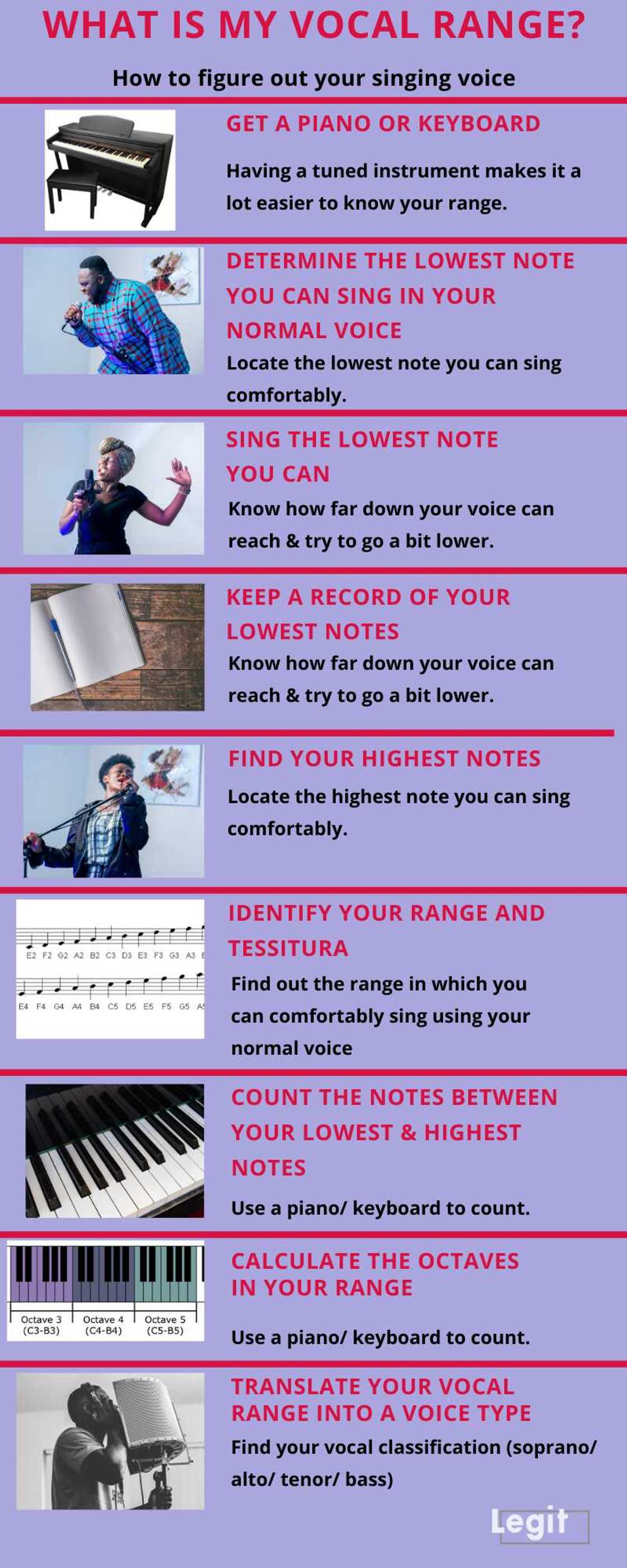What is my vocal range: How to figure out your singing voice
Most of us have embarrassed ourselves in front of our friends by singing off-key and off-tune, especially during a karaoke night out. You can save yourself from recurrent embarrassment by finding out what your vocal range is.

Source: Original
What is my vocal range? Vocal range is a range that describes the lowest possible note you can sing to the highest one you can sing. If you are applying for a singing gig, it is extremely important to know both your lowest and highest pitches.
What is my vocal range? Figure it out now
Everyone is familiar with words like bass, tenor, alto, and soprano, but most people do not know their voice ranges. Your vocal range is a range that describes the lowest to the highest musical sound in which you can sing.
Determining your voice type is a really simple exercise that is worth spending a bit of time on as a beginner.
How do you determine your vocal range? Although you may be able to reach different notes when singing, comfort is key when it comes to making a decision about the highest and lowest notes you can hit.
It is indisputable that musical terminology can be confusing, and you may wonder how to begin defining your voice on paper. Have no fear because the steps contained in this elaborate guide will offer plenty of insight.
1. Get a piano or keyboard
Having a tuned piano or keyboard that you can play as you sing makes it much easier to know your range.
If you do not have access to the physical instrument, download a free piano app on your smartphone, tablet, or even laptop.
The downloaded app will give you access to a fully simulated keyboard and will indicate the correct scientific pitch notation for each key as you play.

Source: UGC
2. Determine the lowest note you can sing in your normal voice
The second step in the "how to find the range of my voice" guide is figuring out the lowest note you can sing in your modal voice. This means locating the lowest pitch that you can sing comfortably without your voice croaking or cracking.
You should not have to “breathe” the note, meaning that its tone quality should match that of the rest of your chest voice. To do this effectively, use the tips below:
- Start by singing a higher pitch on a consistent vowel sound instead of trying to pull your lowest note out of thin air. Afterwards, work your way down the scale into your lowest registers.
- For females, it is best to start with the easy middle C on the piano (C4) then work your way down the keys. Match each note until you hit your lowest.
- For males, playing a C3 on the piano then going down one key at a time from there is the best way to do it.
- Remember that the ultimate goal is to find the lowest register you can still sing comfortably, so do not count any notes that you cannot sustain.
3. Sing the lowest note you can, including breathing
The vocal range chart is quite wide, and each person has their range. Once you know how far down your voice can reach, try to go a bit lower, key by key, and note by note.

Source: Instagram
Count all the breathy notes that you can sustain, but do not count all the croaky ones that you cannot hold. It is necessary to know that for some singers, their normal and breathy lowest notes may coincide while for others, they might not.
4. Keep a record of your lowest notes
After you have found the results of the vocal range test in steps 1-3 above, write down your lowest normal-voiced register and the lowest one you can reach.
To make this record, identify the piano key that corresponds to the pitch and then figure out its correct scientific pitch notation.

Source: UGC
5. Find your highest notes
Now that you have already learned how to find your vocal range, particularly the lowest notes, you should find your highest ones. The steps to do this are similar to steps 1-4 above.
Start with a higher register that you have no problem reaching, and go up the scale key by key, but do not let yourself go into falsetto.
For females, start by playing a C5 on your piano and work your way up from there, going key by key. If you are male, start by playing and matching a G3.
Find the highest pitch you can hit without significantly changing your tone quality or the natural action of your vocal cords.
If you hear a break or new breathiness in your voice or even feel a difference in how your vocal cords are working to produce a note, then you have passed your modal register.
Sing the highest note you can in falsetto. Most people can use falsetto, a mode in which the vocal cords remain open and relaxed and vibrate much less.
This allows you to go lighter and higher than you can in your normal register. After finding the highest note you can sing comfortably, relax your vocal cords before trying to see if you can push yourself a bit higher beyond your normal voice.
Do not forget to record your results.
6. Identify your range and tessitura
By now, you have written down or recorded four notes, that is, two low and two high, in scientific pitch notation. Write them down again in ascending order, that is, from lowest to highest.
Put parentheses around the lowest and highest pitches and a dash in between the middle two as this is the notation that expresses your full vocal range.
The two middle pitches, which some people call the average vocal range, are your tessitura. Tessitura refers to the range in which you can comfortably sing using your normal voice.
Having this knowledge is very helpful in knowing how to select the appropriate voice type for singing.
7. Count the notes between your lowest and highest notes
To conduct this step, use your keyboard or piano to count the notes between the lowest one you could sing and the highest. Do not count the black keys.
8. Determine the octaves in your range
One octave is an interval of eight notes. A to A, for instance, is an octave. You have to be aware that the last A will also count as the start of the next octave.
Having this in mind, determine the number of octaves in your vocal range by counting the total number of notes between your highest and lowest pitches in sets of seven.
Make sure that you include the partial octaves too as it is normal for someone to have a range of 1.5 octaves in full voice. The half comes about because a person can comfortably sing three or four notes in the next octave.

Source: UGC
9. Translate your vocal range into a voice type
Now that you have written down your details using scientific pitch notation, you can use this information to determine your vocal classification.
Each voice type has an associated range, so find which type aligns your full range.
- The classifications for different voice types are soprano B3-G6, mezzo-soprano G3-A5, alto E3-F5, countertenor G3-C6, tenor C3-B4, bass D2-E4 or baritone G2-G4.
- If yours does not fit into these standard options, select one that is closest.
- If your full range does not seem to fit into a single voice type, use your tessitura to see which type it most closely matches with. You should pick the type in which you will be most comfortable singing.
Points to know beforehand
Before you take any online "what is my vocal range quiz" or conduct the steps above, you need to have some background knowledge:
- You should know the different voice-type classifications. Most people have heard the words soprano, tenor, or bass, but do not necessarily comprehend their meaning.
The different voice types descending from highest to lowest are soprano, mezzo-soprano, alto, countertenor, tenor, baritone, and bass. Each type has an associated vocal range.
- Learn to distinguish between different vocal registers. Your modal voice is essentially your comfortable singing range when the vocal folds are in their natural manner of action, while the head voice includes the high end of your range.
On the other hand, vocal fry is the lowest vocal register for the very low-voiced male while the whistle register refers to the super-high notes that some women can hit.
- Make a point of learning more about octaves, that is, the interval between two like notes.
- It is important to remember that vocal classification is not related to singing ability. Many exceptional singers have a narrow range but they still produce a beautiful sound.
- Gain a basic understanding of scientific pitch notation, which is a standardized way of writing and understanding musical notes using letters. The full expression of your vocal range will include three of four different scientific pitch notation numbers.
Have you determined your vocal range using the steps above? If so, share your results with us in the comment section.
Source: Legit.ng










